Windmill Guard - Georgia Kenpo
Main menu
- Home Page
- About Our Kenpo Requirements
-
Belt Requirements
-
Beginning Levels
- Yellow Belt
- Orange Belt
- Purple Belt
- Blue Belt
- Green Belt
-
Intermediate Levels
- 3rd Brown Belt
- 2nd Brown Belt
- 1st Brown Belt
-
Advanced Levels
- Shodan
- Nidan
- Sandan
- Yodan
- Godan
-
Techniques by Attack
- Punch Techniques
- Punch Combinations
- Punch from the Side
- Punch Combinations from the Side
- Grab/Punch
- Chokes
- Club Techniques
- Grab Techniques
- Wrist Grabs & Handshakes
- Gun Techniques
- Holds & Hugs Techniques
- Kick Techniques
- Kick/Punch Combination Techniques
- Knife Techniques
- Locks
- Multiple Opponents
- Offensive Techniques
- Push Techniques
- Tackle Techniques
- Defense against Blocks
-
Beginning Levels
- Separator 1
- Kenpo Profiles
- Testimonials
- Promotions Pages
- Featured Techniques
- Pictures
-
Articles
- GM Pat Munk's Articles
- GM Ted Sumner's Articles
- Marietta Journal Article about Pat Munk
- My Shodan Test
- 1st Degree Novice or Expert
- Cross Training in Boxing & Kick Boxing
- Kata as Mental Exercise
- What is Kenpo
- Kenpo Karate or Kenpo JuJitsu
- Ju Jutsu
- Handbook/Bylaws
- Creed & Pledges
- Separator 3
- Our Kenpo Lineage
- Why Choose Us
- Our Belt System
- Kata Names
- Laws of Kenpo
- History of the Belt
- Japanese Terms
- Tying your belt
- Definition of Kenpo
Windmill Guard
Featured Technique
Windmill Guard
Windmill Guard is the 5th self defense technique taught in Purple Belt
Windmill Guard is a Classical Reference Technique and is one of the best techniques that you can use against a punch. It's quick, effective, and very practical. This technique should be practiced on both sides so you can utilize it against both a right or left punch. Variation "A" is used against a right punch, and variation "B" is used against a left punch.
Note: It doesn't matter which foot the opponent has forward as he throws the punches but we usually will have the opponent stepping with his right foot as he throws a right punch.
Note: During this technique we will be using a 45' angle step to 10:30 to avoid the punch. This angle is used as a standard reference. In actual practice you will step to whatever angle that will put you in the best position to deliver the roundhouse kick. Depending on how close or how far the opponent is from you as he steps will determine what angle you will use. The closer he is to you the less angle you will use even to the point of stepping back at an angle. The farther away the opponent is to you the higher angle you will use, i.e. you might have to step to 11:00 or 11:30 angle.
Note: The hand movements (of the parry) can be done with closed fists or with open hands. It's best for the beginner to use closed fists because there is less chance of jamming the fingers, as the student gets more advanced the open hands should be used for better control of the opponent's punching hand.
The weapons you use in Windmill Guard are: The Wheel Kick, or Round House kick.
The Targets attacked in Windmill Guard are: The mid-
The stances used in Windmill Guard are: The Horse Stance, Full Bow Stance.
The block used in Windmill Guard is: The Windmill Parry.
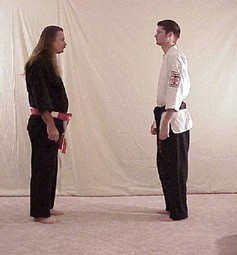
This technique starts with your feet together and you are facing the opponent who is at 12:00.
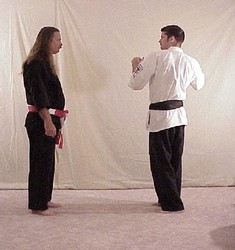
The Opponent starts to throw a right punch.
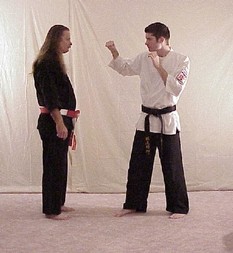
As the opponent throws a right punch he steps forward with his right foot.
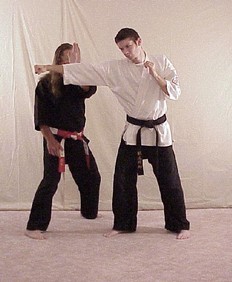
Step forward with your left foot at a 45' angle to 10:30 into a Fighting Horse Stance, as you step your left hand parries the punch. Your right hand should be down covering your groin as it moves in a clock-
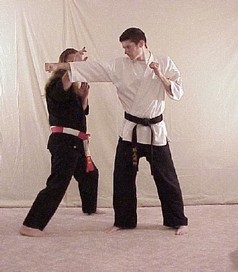
Your right hand continues it's clock-
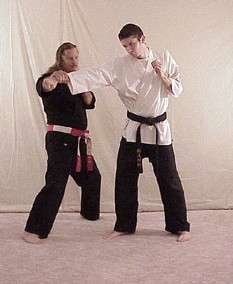
After your right hand makes contact with the opponent's punching arm grab his wrist with your right to control the opponent's punching arm.
The technique will still work even if you do not or cannot grab the opponent's arm so don't be alarmed or concerned it you miss the grab.
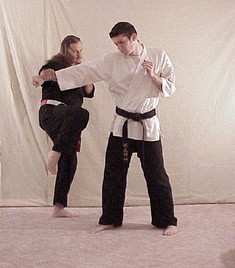
After the grab of the opponent's arm shift your weight slightly to your left and prepare to throw the Wheel Kick.
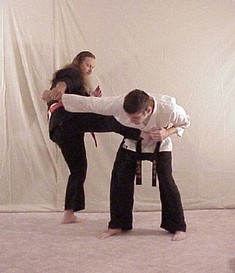
Throw the Wheel Kick using the top of the foot to the opponent's mid-
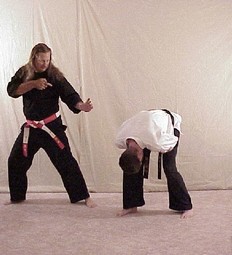
After the Wheel Kick plant the kicking foot back to clear out.
If needed you can plant the kicking foot down forward and into the opponent and follow up with appropriate hand strikes if the kick wasn't totally effective.
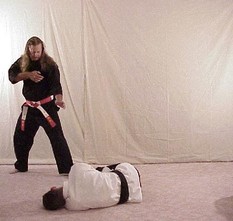
After clearing out from the roundhouse kick be sure to be ready just incase the opponent is still able to continue the attack.
Kicking Theory: In Kenpo the standard way of throwing a Wheel Kick, Round House Kick, is with the top of the foot. This is done because there is less chance of injuring the foot, particularly the toes, you also have greater reach, and can generate more power.
In the classical systems of Karate, the Round House Kick is always done with the ball of the foot because of the belief that you can generate more power using the ball of the foot.
Using a computer to test and measure the power of kicks and punches, we have found that using the top of the foot to deliver the Wheel Kick, Round House Kick, delivered more power than a Round House Kick delivered with the ball of the foot. Why?
1. When the ball of the foot is used to deliver the Round House Kick, the muscle groups are shortened and tightened which decreases the speed.
2. When you kick with the top of the foot the muscle groups are looser and the kick can be thrown with more power because there is more speed.